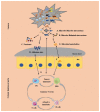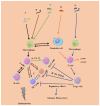Beyond Just Bacteria: Functional Biomes in the Gut Ecosystem Including Virome, Mycobiome, Archaeome and Helminths
- PMID: 32231141
- PMCID: PMC7232386
- DOI: 10.3390/microorganisms8040483
Beyond Just Bacteria: Functional Biomes in the Gut Ecosystem Including Virome, Mycobiome, Archaeome and Helminths
Abstract
Gut microbiota refers to a complex network of microbes, which exerts a marked influence on the host's health. It is composed of bacteria, fungi, viruses, and helminths. Bacteria, or collectively, the bacteriome, comprises a significant proportion of the well-characterized microbiome. However, the other communities referred to as 'dark matter' of microbiomes such as viruses (virome), fungi (mycobiome), archaea (archaeome), and helminths have not been completely elucidated. Development of new and improved metagenomics methods has allowed the identification of complete genomes from the genetic material in the human gut, opening new perspectives on the understanding of the gut microbiome composition, their importance, and potential clinical applications. Here, we review the recent evidence on the viruses, fungi, archaea, and helminths found in the mammalian gut, detailing their interactions with the resident bacterial microbiota and the host, to explore the potential impact of the microbiome on host's health. The role of fecal virome transplantations, pre-, pro-, and syn-biotic interventions in modulating the microbiome and their related concerns are also discussed.
Keywords: archaeome; fecal virome transplants; gut microbiota; helminths; mycobiome; virome.
Conflict of interest statement
Funding: No funding was involved.
Figures



Similar articles
-
The Unexplored World of Human Virome, Mycobiome, and Archaeome in Aging.J Gerontol A Biol Sci Med Sci. 2020 Sep 25;75(10):1834-1837. doi: 10.1093/gerona/glz274. J Gerontol A Biol Sci Med Sci. 2020. PMID: 31802114 Review.
-
Gut Microbiota beyond Bacteria-Mycobiome, Virome, Archaeome, and Eukaryotic Parasites in IBD.Int J Mol Sci. 2020 Apr 11;21(8):2668. doi: 10.3390/ijms21082668. Int J Mol Sci. 2020. PMID: 32290414 Free PMC article. Review.
-
Characterizations of the Gut Bacteriome, Mycobiome, and Virome in Patients with Osteoarthritis.Microbiol Spectr. 2023 Feb 14;11(1):e0171122. doi: 10.1128/spectrum.01711-22. Epub 2022 Dec 14. Microbiol Spectr. 2023. PMID: 36515546 Free PMC article.
-
Gut microbiota and inflammatory bowel disease.WIREs Mech Dis. 2022 Mar;14(2):e1540. doi: 10.1002/wsbm.1540. Epub 2021 Oct 15. WIREs Mech Dis. 2022. PMID: 35266651 Review.
-
Insights into gut microbiomes in stem cell transplantation by comprehensive shotgun long-read sequencing.Sci Rep. 2024 Feb 19;14(1):4068. doi: 10.1038/s41598-024-53506-1. Sci Rep. 2024. PMID: 38374282 Free PMC article.
Cited by
-
The Microbiota-Gut-Brain Axis in Psychiatric Disorders.Int J Mol Sci. 2022 Sep 24;23(19):11245. doi: 10.3390/ijms231911245. Int J Mol Sci. 2022. PMID: 36232548 Free PMC article. Review.
-
In vitro human gut microbiota fermentation models: opportunities, challenges, and pitfalls.Microbiome Res Rep. 2023 Jan 17;2(1):2. doi: 10.20517/mrr.2022.15. eCollection 2023. Microbiome Res Rep. 2023. PMID: 38045607 Free PMC article. Review.
-
Differences in the composition and predicted functions of the intestinal microbiome of obese and normal weight adult dogs.PeerJ. 2022 Feb 16;10:e12695. doi: 10.7717/peerj.12695. eCollection 2022. PeerJ. 2022. PMID: 35190784 Free PMC article.
-
The Hidden Effect of Nod2 in the Host/Microbiota Relationship.Cell Mol Gastroenterol Hepatol. 2020;10(2):424-425. doi: 10.1016/j.jcmgh.2020.05.001. Epub 2020 May 29. Cell Mol Gastroenterol Hepatol. 2020. PMID: 32479755 Free PMC article. No abstract available.
-
EnsembleSeq: a workflow towards real-time, rapid, and simultaneous multi-kingdom-amplicon sequencing for holistic and resource-effective microbiome research at scale.Microbiol Spectr. 2024 Jun 4;12(6):e0415023. doi: 10.1128/spectrum.04150-23. Epub 2024 Apr 30. Microbiol Spectr. 2024. PMID: 38687072 Free PMC article.
References
-
- Vemuri R., Gundamaraju R., Shastri M.D., Shukla S.D., Kalpurath K., Ball M., Tristram S., Shankar E.M., Ahuja K.D., Eri R. Gut Microbial Changes, Interactions, and Their Implications on Human Lifecycle: An Ageing Perspective. BioMed Res. Int. 2018;2018:1–13. doi: 10.1155/2018/4178607. - DOI - PMC - PubMed
-
- Vemuri R., Sylvia K., Klein S.L., Forster S.C., Plebanski M., Eri R., Flanagan K.L. The microgenderome revealed: Sex differences in bidirectional interactions between the microbiota, hormones, immunity and disease susceptibility. Semin. Immunopathol. 2018;41:265–275. doi: 10.1007/s00281-018-0716-7. - DOI - PMC - PubMed
Publication types
LinkOut - more resources
Full Text Sources
Miscellaneous

